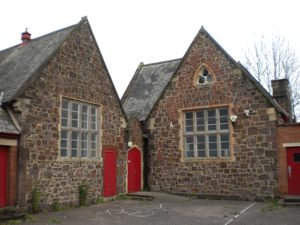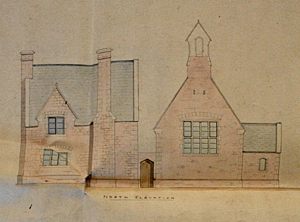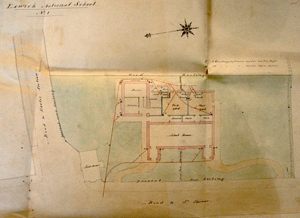
Exwick School
Written and researched by Julia Sharp
Page updated 16th June 2014
During the first half of the 19th century, education for the masses was a constant theme. For Exwick the Post Office Directory of 1856 notes ‘There are Day and Sunday Schools for Boys and girls. The School mistress is supported by voluntary contributions and children’s pence.’ Encouraged by the Rev. John Medley, Vicar of St. Thomas, before he left to become Bishop of Frederickton in Canada, the local gentry agreed that this was not enough.
The owners of suitable land near Exwick Chapel were James Wentworth Buller (who had previously given the land for the Church) and his eldest son James Howard Buller. They donated the land on which the school is built and it was conveyed to ‘the Minister and Church Wardens of St. Thomas the Apostle in the County of Devon’ on 8 August 1859 under the authority of the Parliamentary Acts for the conveyance and endowment of Sites for Schools that had recently been passed. The site consisted of ‘part of a field called Path Meadow situate in the Hamlet of Exwick in the Parish of St. Thomas the Apostle Devon’. The buildings to be erected thereon were only to be used as a School for children and adults or children only of the labouring manufacturing and other poorer classes. There was a Committee set up to fund the expenses and ensure the school offered a religious education. James Wentworth Buller, James Howard Buller, Thomas Maitland Snow, Robert Maunder, Thomas Welby Northmore, and John Northmore were the original members of that Committee and they each agreed to pay the sum of twenty shillings each year into the funds of the School. In addition a Committee of not more than four Ladies could be elected to assist in the visitation and management of the Girls and Infant School.
The school opens
Plans dated 20 June 1859 were submitted with A Westlake as the Architect and John Moore as the builder. Work started as soon as a Government Building Grant was received in 1860, enabling the newspapers to include details of the opening ceremony on 18 August 1860. The Vicar took the position of Manager of the School and the number of pupils continued to increase. The next change was the 1870 Education Act which set up School Boards elected by the ratepayers in the area. The local board for Exwick was the School Board for St. Thomas the Apostle. This Act was the first that allowed women to stand for election to their local Board and also vote. No women in Exwick stood for election, indeed only four were elected over the whole country – but it was a start.
St. Thomas School Board was set up in early 1871 and Exwick School was offered to them and terms were agreed in July of that year. It then became clear that the original conveyance had not been completed in full but it was decided to continue without waiting for the further conveyance of the school to the Board. Transfer was made that Christmas with the School opening as a Board School on 8 January 1872, without all the documentation in place.
The paperwork was still not complete by 1874, as the documents had not been signed due to the fact the Rev. Howard Vicar of St. Thomas had died before he was able to sign. There was now an urgent need for an additional room, as there were complaints that upwards of 20 children had to be turned away and the School Mistress was compelled to keep down average attendance. The additional classroom, for the infants, was built in 1875 and a Memorandum of Arrangement signed in June 1875 whereby the School was effectively transferred to St. Thomas School Board. The Vicar of St. Andrews Exwick, Rev. William Cobham Gibbs was given use of the School, but not the School House, on Sundays, Christmas Day and Good Friday, all week from 8.45am to 9.45am (for religious instruction for the pupils) and weekdays from 6pm on Tuesday Thursday and Saturday. Some members of the School Board questioned whether allowing Rev. Gibbs use of the School on Sundays meant they would have to allow other sectarian bodies to hire the School on Sundays. Therefore permission was withheld for that part of his request.
This question did not go away as in 1881 St. Thomas School Board was again debating the question of use of the School, this time the applicant was Rev. John Lomax Gibbs, another nephew of William Gibbs of Tyntesfield. John Gibbs was asking not only for the use of the School on Sunday but the use of the ‘new’ classroom during the week. This came up against fierce resistance, mainly on the grounds that some parents did not wish their children ‘to come under Mr. Gibbs tuition’ and this small classroom was the only place they could stay other than outside. The Board members felt strongly that this room should be retained for the use of the children of people of other denominations than the Church, but in the end he was allowed to rent it for £10 a year, which was enough to cover the cost of financing the building of the new classroom. In 1883 the School House was extended with another bedroom and extension of the kitchen. This was the last significant additional building on the site.
In 1900 St. Thomas became part of Exeter and the Exeter School Board took over from St. Thomas School Board. This did not last long as the 1902 Education Act abolished School Boards and replaced them with Local Education Authorities (LEAs) which were created to organise funding, employ teachers and allocate School places.
During the 19th century and up to World War 1, there were some problems with the older children having duties at home, keeping them away from school, girls expected to look after babies while mother was out washing, probably employed in the Laundry. Boys undertaking beating for shooting parties, haymaking, fruit picking and gardening, were other usual excuses noted in the School Log book.
There were a number of events that were celebrated, including the relief of Mafeking and Peace in South Africa. One notable event was the freeing of the Road and Bridge from the Toll when Exeter took over St. Thomas. The Vicar of the time wrote a report on the Funeral of the Old Toll Gate which is included in the article on Exwick Toll House.
Royal occasions such as Queen Victoria’s Diamond Jubilee, Coronations of Edward VII, George V and George VI and the Silver Jubilee of George V, were all days when the Children received mugs and usually a Celebration tea. In 1953 a fancy dress competition was held as part of the celebrations for the Coronation of Queen Elizabeth II, with the children gathering outside in the playground getting damp, for the usual photograph.
One significant Master was Adolphus Herbert Rousham who became Schoolmaster in 1891, assisted by his wife Lilla as School Mistress. He was a pillar of the Exwick community for most of the first quarter of the 20th Century. As well as being the Schoolmaster, he wrote the booklet about Exwick in the Great War, and appears as Secretary of many of the projects such as building the War Memorial followed by the Parish Institute. He served as a Church Warden, even Sequestrator when necessary, until he retired in 1924. The Churchwardens Staves in the aisle of the Church are dedicated to his memory.
The building continued in use as the Junior School until 1971, when a new School was built nearby and named Foxhayes School. Slightly later, part of the Old School was brought back to use for a short time when there were too many pupils for the new school. This led to an additional School being built, Exwick Middle School, which took the older children. Both of these have now closed with the opening of Exwick Heights School in the early 21st century, already extended within five years of erection.
Following the closure of the School, the building was renamed Centre Exe and used as a Community Centre until 2009. Various organisations met there such as a Kindergarten, Boys Brigade, Adult Learning, Youth Clubs, Choir, Scouts, Guides and the Living Here Project – West of the Exe part of the outreach while RAMM, Exeter’s Museum was undergoing an update. The fabric of the building was showing its age before the Kinnerton Way Community Centre opened in 2008, which took over most of the activities.
Exwick was prone to floods on a regular basis, and these often cut off the School, sometimes surrounding the building and entering the classrooms and house. This has been alleviated by the building of the radial gates on the River Exe and the construction of the Flood Relief channel in Exwick.
The ownership of the building has been transferred to the successors of the original Trustees by Devon County Council. The Trustees have leased it to Exwick Ark Nursery and Pre-School who undertook a full make over and opened in 2013.
Extracts from various newspapers including Western Times, Plymouth Gazette, School log books, Exeter Flying Post, Bovett, School Buildings in Exeter 1800-1939, various items on the internet.
 The two main school rooms at Exwick School. Photo Julia Sharp.
The two main school rooms at Exwick School. Photo Julia Sharp. Floods were a perennial problem at the school.
Floods were a perennial problem at the school.
 Detail from the main plan for the school.
Detail from the main plan for the school.
 The plan for Exwick School.
The plan for Exwick School.
│ Top of Page │